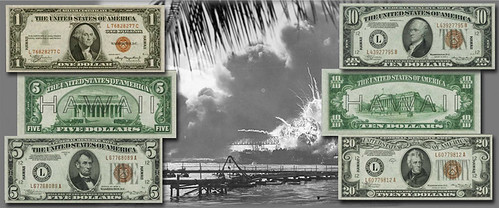
PREV ARTICLE
NEXT ARTICLE
FULL ISSUE
PREV FULL ISSUE
EMERGENCY ISSUE HAWAII NOTES OF WORLD WAR II
Brad Ciociola, Currency Specialist with Stack's Bowers, published a blog article this week on the numismatic ramifications of
“December 7th, 1941, a date which will live in infamy.” -Editor

This Monday marked the 74th anniversary of the Japanese attack on the United States naval base at Pearl Harbor, Hawaii. The attack killed over 2,400 Americans and drew the United States into World War II. Now, more than seven decades after President Franklin Delano Roosevelt made his famous remarks in his address to the nation after the attack, his words remain as true as ever. December 7th remains one of the most pivotal days in our nation’s history. In the aftermath of the attack on Pearl Harbor, United States military officials feared that if the Japanese invaded the Hawaiian Islands they could seize a large amount of United States currency from banks and individuals. To thwart any possible threat to America’s money supply, on January 10, 1942, Military Governor Delos Carleton Emmons ordered all regular US paper money on the islands to be recalled, save for small amounts that could be kept for individuals ($200) and businesses ($500). On June 25, 1942, new notes were issued for the islands in $1, $5, $10 and $20 denominations. The notes issued closely resembled existing U.S. notes except that they featured brown Treasury Seals and “HAWAII” overprinted on the front and back in black. On the face the overprint is small and appears once each on the far left and right ends of the note. The backs are overprinted in just a single large HAWAII in black outlined letters centered in the middle of the back. The idea was that if the Japanese invaded Hawaii the U.S. could immediately declare the newly issued Hawaii overprinted notes worthless. The government used a mix of both Silver Certificates and Federal Reserve Notes for the Hawaii emergency issue. The $1 notes were Silver Certificates from the Series of 1935 A. All of the $5, $10 and $20 notes were Federal Reserve Notes from the San Francisco Federal Reserve District. The $5 notes were issued under both the Series of 1934 and the Series of 1934 A. Only the series of 1934 A was used for the $10 denomination while both the Series of 1934 and the Series of 1934 A were used for the $20. The military government of Hawaii ordered all Hawaii residents to turn in their non-Hawaii overprinted notes in exchange for the new emergency issue notes by July 15, 1942. Beginning August 15, 1942, no other paper currency could be circulated on the islands without special permission. Instead of shipping the redeemed currency back to the U.S. mainland, officials decided to destroy it using local facilities. For this purpose they employed a local crematorium and then a sugar mill to destroy $200 million worth of U.S. currency. The Hawaii emergency notes were issued until October 21, 1944, and by April of 1946 they were being recalled from circulation. Print totals for the denominations were 35,052,000 for the $1 denomination, 9,416,000 for the $5 notes, 10,424,000 for the $10 bills and 11,246,000 for the $20s. Each denomination also had replacement notes printed and issued. All Hawaii Star Notes are scarce with many examples of the higher denominations being quite rare. There are also mule and non-mule varieties in the $5 and $20 denominations.
Nice summary. I wasn't aware of the local destruction of the old notes, but that makes sense. -Editor
To read the complete article, see:
Wayne Homren, Editor The Numismatic Bibliomania Society is a non-profit organization promoting numismatic literature. See our web site at coinbooks.org. To submit items for publication in The E-Sylum, write to the Editor at this address: whomren@gmail.com To subscribe go to: https://my.binhost.com/lists/listinfo/esylum All Rights Reserved. NBS Home Page Contact the NBS webmaster 
|